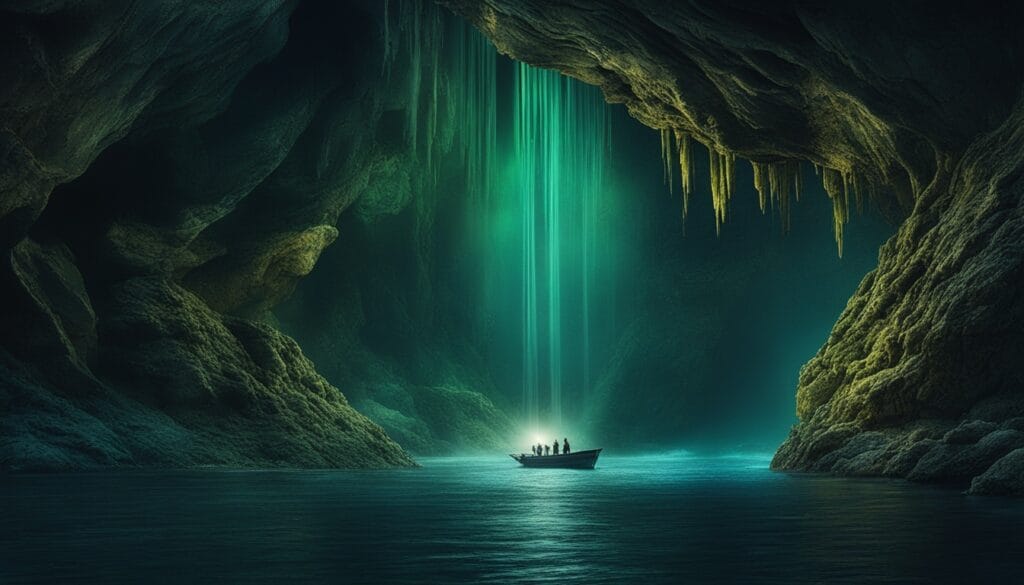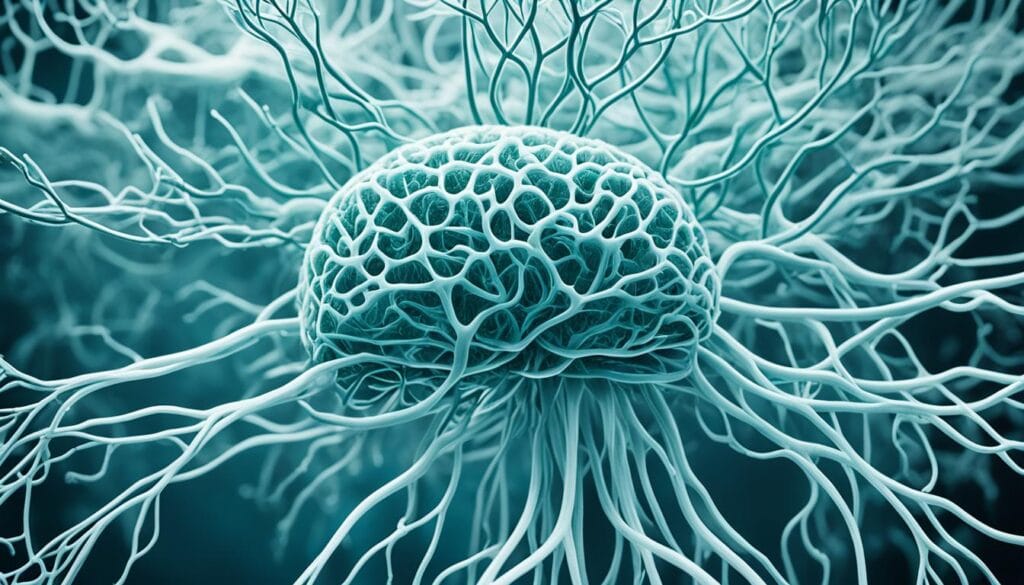Science fiction can’t even begin to capture the many strange occurrences and unexplained phenomena we see today. Our world and beyond are full of mysteries that challenge even the smartest minds. Things like paranormal experiences and anomalous events make us question what’s possible.
Imagine the vast, dark universe where most matter is thought to be hidden as dark matter. It’s a mystery despite years of searching. Then there’s the ocean’s deep, mysterious zone that might be full of life we’ve never seen. And let’s not forget Venus, with its extreme heat and thick atmosphere.
On Earth, the slime mold shows us a new kind of intelligence, solving puzzles without a brain. Meanwhile, diseases leave us with questions that doctors are still trying to answer. Each mystery invites us to explore and learn, challenging our current knowledge.
As we push the limits of what we know, we realize how much our universe still holds. The search for answers is a never-ending journey. In these mysteries, we find the spark for curiosity and the chance for new discoveries that could change how we see the world.
Exploring Dark Matter: The Invisible Universe
The universe is full of dark matter and dark energy, making up a big part of what we can’t see. Dark matter plays a big role in how the universe is shaped and grows. Yet, it’s still a mystery in the field of astrophysics. It makes up about 25% of the universe but we can’t see it directly. We know it’s there because of its gravity.
Understanding the Basics of Dark Matter
Dark matter is different from the 5% of the universe we can see. It doesn’t reflect, absorb, or emit light, so it’s invisible. Scientists think it’s made of something very different from stars and galaxies. They use new technologies and theories to learn more about it.
The Extensive Search for Invisible Matter
Finding out about dark matter is a big challenge. Scientists use special tools and observations to study it. The Vera C. Rubin Observatory in Chile and the Legacy Survey of Space and Time (LSST) are big projects to map the invisible universe. They will give us a lot of data to help understand dark matter and dark energy.
Here’s a quick look at the important stats on dark and visible matter in the universe:
| Category | Percentage of Universe’s Mass | Notes |
|---|---|---|
| Dark Energy | ~70% | Implicated in the accelerating expansion of the universe |
| Dark Matter | ~25% | Does not interact with electromagnetic forces |
| Visible Matter | ~5% | Includes stars, planets, galaxies |
The table shows how much dark energy and dark matter dominate our universe. These numbers highlight parts of the universe we don’t fully understand. But they are key to understanding how the universe works and what its future holds.

Studying dark matter and dark energy is hard but important. It helps us see the invisible universe and changes how we think about physics and the universe. It makes us question our understanding of existence.
Twilight Zone of the Ocean Depths
The twilight zone of the ocean depths is a mysterious place. It’s filled with thick water and is always in shadow. This area, between 200 and 1,000 meters deep, is crucial for the climate and home to unique marine life.
The Mystery of the Ocean’s Middle Layer
The twilight zone, or mesopelagic layer, is one of the ocean’s least known parts. Studies now show it might have a fish population ten times bigger than the surface. Creatures like the bristlemouth fish are found here, possibly the most common vertebrates on Earth.

Unseen Marine Life and Climate Impact
This zone is key to the Earth’s climate. About 90% of the carbon that sinks here stays, keeping it out of the air for thousands of years. It helps move carbon from the surface to deeper parts of the ocean, where it’s stored.
The creatures in this zone move daily, creating the biggest animal migration on Earth. This helps take carbon out of the atmosphere.
| Aspect | Detail |
|---|---|
| Fish Biomass | Exceeds that of all ocean’s surface layers combined |
| Key Species | Bristlemouth fish, possibly the most abundant vertebrate |
| Carbon Isolation | About 90% of carbon remains isolated in this zone |
| Biological Pump | Transfers carbon from surface water to deep ocean |
| Major Processes | Includes largest animal migration on Earth |
The twilight zone is full of life and plays a big role in our climate. It’s important to study and protect this area. This will help us understand more about marine life and how to protect our oceans.
The Enigmatic Climate Transformation of Venus
Venus, our neighbor, was once like Earth, possibly even habitable. Now, it’s covered in high temperatures and a thick atmosphere of carbon dioxide. This change shows how planets can transform significantly. It helps us learn about Venus and other planets like it.
Paradise Lost: The Radical Change of Venus
Historical data shows Venus might have had oceans and been stable for 3 billion years. This challenges our view of Venus as a barren planet. A major event about 700 million years ago changed everything, starting a runaway greenhouse effect.
Before, Venus was cooler, with temperatures between 68°F and 122°F, perfect for water. But volcanic activity released a lot of carbon dioxide, making the planet too hot for life.
Investigating the Hypotheses Behind Venus’s Scorching Environment
Studies suggest Venus started cooling and absorbing carbon dioxide into its crust about 4.2 billion years ago. But volcanic gases released the carbon dioxide back into the air. This made Venus hot and dense.
These studies show how complex planets can be and how life-supporting conditions can change quickly. Venus’s story teaches us about the evolution of planets and the dangers of rapid climate change.

Future Evolution: Predicting Animal Adaptations
As our planet changes fast, scientists are keen on understanding how animals will adapt. They look at how species will adjust to changes in climate, living spaces, and the variety of life on Earth. This is key to guessing what the future holds for life on our planet.
Speculating on the Influence of Humans on Animal Evolution
Humans have greatly changed the environment, pushing many species to adapt quickly. Patricia Brennan, an expert in evolution, thinks animals might change to keep moisture in or stay cool in hotter, drier places. Humans might also speed up these changes with new technologies, leading to big changes in how animals look and act.
The Role of Environmental Change in Shaping Tomorrow’s Fauna
Changes in the environment, like losing natural habitats, changing weather, and new species arriving, are key to how animals will survive. Warmer temperatures and shifting weather patterns could make animals better at handling heat or saving water. Also, animals might change to deal with new threats or competitors brought by humans, which could affect if they survive or not.
The Cause Behind Alzheimer’s Disease
Alzheimer’s disease is a complex condition that puzzles scientists globally. It’s not just about the symptoms but also its causes. The main idea is that amyloid plaques in the brain lead to cognitive decline. But, new studies suggest that viral infections might also play a role, showing there’s more to it.

Alzheimer’s affects many people, especially those over 65. In the U.S., about 6.5 million people in this age group have it. Some groups, like those with Down syndrome or the APOE ε4 gene, are more likely to get it early.
Genetics is a big factor, with certain genes making the disease almost certain by middle age. But lifestyle also matters. Heart disease, diabetes, obesity, and being lonely can increase the risk. Most Alzheimer’s patients in the U.S. are over 75, showing age is a big risk.
Women are more likely to get Alzheimer’s because they live longer than men. These facts highlight the need for more research. By looking into other factors, like amyloid plaques and beyond, doctors aim to find new ways to prevent and treat Alzheimer’s.
Intelligence Without a Brain: The Puzzling Slime Mold
Slime mold, especially Physarum polycephalum, shows us a unique kind of intelligence without a brain. These simple organisms perform complex tasks that seem like they’re making decisions, just like animals do. They don’t have a brain, but they can solve problems in ways we thought only smart animals could.

Researchers have found that Physarum polycephalum can solve mazes and create complex networks, like city transport systems. This shows us that these slime molds are not just simple organisms. They are complex beings that can solve problems at a high level. This could lead to new ways we use technology, like better network planning.
| Behavior | Experiment Findings | Implication |
|---|---|---|
| Decision-making | Physarum made decisions based on strain patterns in its environment, avoiding those with a TRP channel-blocking drug. | Showcases the ability to process and react to environmental stimuli effectively. |
| Optimal foraging | Audrey Dussutour found slime molds choose food mixes with exact nutritional ratios for optimal growth. | Indicates an inherent ability to manage dietary needs efficiently. |
| Pathfinding | Physarum not only navigated mazes but also recreated Tokyo’s railway network minimally. | Validates its capability to find and maintain efficient routes, reducing costs and resources. |
| Spatial memory | Slime molds leave behind a slime trail, which they use to avoid revisiting the same paths. | Gives insight into their memory-like systems despite the absence of a brain. |
The slime mold Physarum polycephalum shows us how smart nature can be, even without a brain. These simple creatures solve complex problems, making us rethink what it means to be intelligent. Their abilities could lead to new ideas in technology and real-world solutions.
Human Longevity: Pushing the Boundaries of Life Span
The search for human longevity and lifespan extension is a big deal. It’s not just science; it’s also about how it affects society and ethical implications. As we get closer to understanding aging, we’re talking more about the big changes it could bring.
Recent stats show that living longer could mean a big boost in the economy. For example, slowing down aging by one year could add $38 trillion to the U.S. economy. If we could add a decade to our lives, the economic gain could be as high as $367 trillion. This would change how we work and share knowledge.
Scientific Advances in Extending Human Life
Medical science has made big strides in lifespan extension. Scientists are finding genes that help us live longer and using biotech to reverse aging in some organisms. Dr. Nir Barzilai and professor David Sinclair are working on making sure we live longer, healthier lives.
Sinclair thinks we could live up to 150 years, just like the early days of cancer research. Besides medicine, living longer also means eating well, staying active, sleeping right, and having good friends. These habits help us live longer and healthier.
Ethical Implications of a Lengthened Lifespan
Thinking about human longevity brings up big ethical questions. Longer lives change how we work, retire, and think about healthcare. They also make us rethink policies and priorities.
There’s a big gap in lifespan between rich and poor in the U.S., showing we need to think about fairness. We’re talking about making sure new life-extending tech helps everyone, not just some.

Humans have always been fascinated by living longer. Now, with new tech, we’re seeing big changes in how we see the future. As we learn more, the story of lifespan extension keeps changing, promising big shifts in society.
Unraveling the Long-Haul Mysteries of Viral Infections
Viral infections are a big health issue worldwide. They leave a lasting effect on people long after they get better. The study of long-haul symptoms from these infections is now a key focus, especially with COVID-19.
The Unknown Link Between Various Post-Viral Syndromes
Some people with viral infections, like COVID-19, face ongoing symptoms that can really affect their life. These symptoms can be hard to deal with and need more research and better treatments.
Long-Haul Symptoms: Medicine’s Under-Recognized Challenge
Doctors are still working to understand and treat long-haul symptoms. These symptoms, from fatigue to brain issues, make managing post-viral syndrome hard.
Here are some key points:
- About 13.3% of people with COVID-19 had symptoms for over 28 days.
- 4.5% had symptoms for more than eight weeks, showing how serious it can be.
- 76% of people recovered from COVID-19 still had symptoms six months later.

The data shows that viral infections can have long-term health effects. We need to learn more about post-viral syndromes. Improving how we handle these issues is key to better patient care and healthcare system readiness.
Dealing with the effects of viral infections requires strong research and support for patients. This will help lessen the impact of long-haul symptoms and boost public health resilience.
Endometriosis: A Misunderstood and Neglected Condition
Endometriosis is as common as diabetes in women but often misunderstood. It causes a lot of pain and doesn’t get enough research or attention. This condition affects millions and disrupts their lives.

It’s estimated that 7.6 million women in the US have endometriosis. But finding out you have it can take up to 12 years. This long wait can lead to more pain and economic problems.
| Condition | Number Affected in the US | Average Diagnosis Time (Years) | NIH Funding Per Person |
|---|---|---|---|
| Endometriosis | 7.6 million | 12 | $0.92 |
| Diabetes | 13.4 million | N/A | $35.66 |
Research funding shows a big difference. In 2020, endometriosis got just $7 million from the NIH, while diabetes got over $1 billion. This means fewer new treatments and less help for pain.
- Nearly 20 million American women could have endometriosis, showing how hard it is to diagnose.
- About 47% of women who can’t get pregnant might have endometriosis, making their struggles worse.
- Those with endometriosis pay an average of $13,199 in healthcare costs in the first year after diagnosis.
Surgeries for endometriosis can take up to nine hours. But, they’re not fully covered by insurance, making it hard for surgeons to help patients.
We need more funding and research for endometriosis. This will help us understand and treat it better, reducing the pain and healthcare issues it causes.
The Evolutionary Significance of the Anus
The study of anuses shows a big change in evolution. Scientists find it fascinating. This simple body part changed how animals eat and get rid of waste. It helped them survive and grow into different kinds of animals.

Scientists say having a separate anus helped animals digest food better. This let animals eat more without stopping to go to the bathroom. This helped them live longer and become more complex.
This big change happened about 550 million years ago. Some species developed anuses on their own. Others didn’t need one because they don’t digest food like we do.
Some animals, like sea sponges and tapeworms, don’t have a digestive system. So, they don’t need an anus. But, some others, like comb jellies, have a special way of being. There’s a lot of debate about if they show what life was like before anuses existed.
Key evolutionary highlights:
- Comb jellies might be early forms without an anus.
- Some animals have more than one anus, showing different ways they’ve adapted.
- Some species lost their anus over time, making us wonder why.
Looking into anuses helps us learn about the past lives of different species. It shows how this organ changed their survival strategies. This knowledge helps us understand nature better and can guide how we take care of the environment.
| Feature | Species | Significance |
|---|---|---|
| Multiple anuses | Warty comb jelly, certain worms | Adaptive trait allowing unique survival mechanisms |
| No anus | Sea sponges, tapeworms | Evolutionary adaptation to specific ecological niches |
| Temporary anus | Warty comb jelly | Efficiency in waste expulsion, maintaining cleanliness |
Studying this important body part in different animals helps us understand evolution better. It shows how complex even the simplest parts of our bodies can be.
Probing the Phenomenon of Ball Lightning
Ball lightning is a mysterious sight that has fascinated people for centuries. It looks like a ball and can move on its own, even though it comes from thunderstorms. Scientists have been studying it to understand this strange event.
Ball lightning shows up during thunderstorms and can move through the air or across surfaces. It leaves people amazed and a bit scared. Its short appearances have led to many studies over the years.
Even though it doesn’t last long, ball lightning has caught the attention of scientists and historians. They are working together to learn more about it.
| Characteristic | Laboratory Observation | Historical Reports |
|---|---|---|
| Size | Approximately 3 cm | Varies significantly |
| Lifespan | Tens of milliseconds to half a second | Seconds to minutes, varies widely |
| Composition | Plasma with substrate materials | Unknown, speculative |
| Behavior | Limited movement, rising and swirling | Hovering, lateral movement, interaction with the environment |
| Color Influence | Sodium chloride contributes to yellow color | Colors vary; often described as fiery or glowing |
| Historical Context | First documented in 1195 | Continued reports up to the modern day |
Scientists try to recreate thunderstorm conditions in labs to study ball lightning. They use a microwave drill to make plasma balls. These experiments show that lab-made plasma balls are similar to the real thing, but they don’t act exactly the same.
Studying ball lightning helps us understand the sky better. It’s a tough subject, but each study brings us closer to solving the mystery. By combining history and science, we can learn a lot about this strange phenomenon.
Mysterious Monuments: The Defiant Moai of Easter Island
The Moai statues of Easter Island have always fascinated people around the world. These statues are like silent guardians of the past. They connect us to the island’s old inhabitants and their society’s collapse. Studying these statues helps us understand their unique craftsmanship and the reasons behind their civilization’s rise and fall.
Deciphering the Collapse of an Isolated Society
The collapse of Easter Island’s society is a mystery that historians and archaeologists find intriguing. Many factors led to this downfall, like environmental damage, using up resources, and maybe even climate changes. The Moai statues remind us of a thriving society that might have used up its resources too much. This led to a big drop in population from over 10,000 to just 111 by the time outsiders arrived.
Understanding the Purpose of the Moai Ceremonial Structures
The Moai statues were made from volcanic ash at Rano Raraku, a quarry on Easter Island. They are big, about 14 feet tall and weigh 12 tons each. These statues were placed on ceremonial platforms called Ahu, facing the villages.
This shows they were important for spiritual and social events. They might have been seen as the spirits of ancestors, watching over and protecting the people. The Moai’s designs and where they were placed show a complex society that could work together on big projects.
Ahu Tongariki is the biggest ceremonial site with many Moai statues. It was rebuilt after a big wave hit in 1960. This site shows how important the Moai were to the community and their culture. It highlights the complexity of Rapa Nui’s ancient society.
Today, the Moai statues still fascinate scholars and tourists. They teach us an important lesson about using resources wisely. They remind us of the delicate balance between progress and protecting our environment.
Ancient Engineering: Secrets of the Great Pyramid of Giza
The Great Pyramid of Giza has amazed people for over 4500 years. It shows the amazing skills of ancient Egypt’s builders. New tech helps us learn more about its hidden parts every year.
New Discoveries in the Pyramid’s Construction
Recent studies have used muon tomography to see inside the pyramid. This method uses cosmic rays to make 3D images. It found a 100-foot void and another small space, showing us how it was built and what it might be for.
Inside the Unexplored Chambers of Giza’s Great Pyramid
The Great Pyramid of Giza still has many secrets. The new chambers might tell us more about Pharaoh Khufu and his rule. This could change what we know about ancient Egypt.
| Specification | Data | Symbolic Significance |
|---|---|---|
| Height | 481 feet | Mathematical encoding of $\pi$ |
| Angle of slopes | 51.85° | Encodes mathematical constants e, $\pi$, and Φ |
| Construction Blocks | 2.3 million limestone and granite | Represents vast resources and labor involved |
| Void Discovery | 100-foot long above the grand gallery | Potential ceremonial or storage purposes |
| Muon Tomography Utilization | Mapping internal structures | Demonstrates advanced use of cosmic rays for archaeological discovery |
| Funding and Project Duration | Requires two years, pending further funds | Indicates ongoing commitment to uncovering the pyramid’s secrets |
Old and new tech together are helping us learn more about the Great Pyramid of Giza. This keeps making it one of the most interesting places in history.
Strange Occurrences
Some places have always sparked wonder and curiosity. The Bermuda Triangle and Poland’s Crooked Forest are two such spots. They are famous for their mysterious nature and supernatural happenings.
The Unsettling Myths of the Bermuda Triangle
The Bermuda Triangle is in the Atlantic Ocean. It’s known for ships and planes vanishing without a trace. It lies between Miami, Bermuda, and Puerto Rico. Even with today’s tech, the Bermuda Triangle still sparks debate about paranormal activities.
The Bewildering Quest to Understand Poland’s Crooked Forest
In western Poland, near Gryfino, the Crooked Forest has about 400 pine trees. These trees bend almost 90 degrees at their base. They were planted in the 1930s and have puzzled everyone since.
Many theories exist, like human actions or strange gravity. But, the real reason for their shape is still a mystery. It makes people wonder about supernatural forces.
| Location | Description | Known Theories |
|---|---|---|
| Bermuda Triangle | A maritime zone famous for its unexplained disappearances. | Environmental factors vs. paranormal theories. |
| Crooked Forest, Poland | A forest with uniquely twisted pine trees. | Human manipulation vs. natural anomalies. |
The Bermuda Triangle and the Crooked Forest are key parts of local and global mysteries. They attract visitors worldwide. While science tries to explain them, supernatural theories keep their charm alive.
Otherworldly Destinations: Unveiling Nature’s Phenomena
Some places on Earth are so strange, they seem like they come from another world. Western Australia’s Lake Hillier and Mauritania’s Richat Structure are two such places. They are mysteries that fascinate scientists and tourists.
The Striking Peculiarities of Lake Hillier
Lake Hillier is known for its bright pink water. It’s in Western Australia and is a sight to behold. The pink color comes from algae that live in the lake. These algae make a red pigment that helps them survive in the sunlight.
People come from all over the world to see this pink lake. It’s not just a pretty sight; it’s also a place for scientists to study.
Mauritania’s Richat Structure: Earth’s Own Eye
In the Sahara Desert, there’s another strange feature called the Richat Structure. It looks like an eye from space and has been a mystery for years. People thought it was a meteorite crater, but it’s actually a dome of rock that erosion has exposed.
This dome has layers of rock that look like a huge bullseye. Geologists and adventurers find it fascinating.
| Feature | Location | Unique Characteristic |
|---|---|---|
| Lake Hillier | Western Australia | Pink water due to algae and prawn |
| Richat Structure | Mauritania, Sahara Desert | Circular geological uplift visible from space |
Lake Hillier and the Richat Structure show how amazing and mysterious nature can be. They tell stories of Earth’s geology and ecosystems. They remind us of the power of nature to amaze and inspire us.
Conclusion
The world is full of enigmatic circumstances, preternatural phenomena, and bizarre incidents. These mysteries cover our understanding of the world and the universe. From deep oceans to the vastness of space, they spark our curiosity and test our minds.
Dark matter, the ocean’s secrets, and our planet’s mysteries call to us. They challenge scientists and adventurers to explore and solve them.
Dr. Bernard Beitman’s Weird Coincidence Survey shows we’re naturally drawn to these mysteries. We seek explanations and meaning, even in random events. This drive to connect things is seen in many areas, from science to spirituality.
Studies show how emotions and beliefs affect our perception of coincidences. This shows our deep desire to understand the unknown. Even statistical methods can’t fully satisfy our need for deeper knowledge.
Our brains are complex when dealing with the unexplainable. Research over the years shows how intelligence, critical thinking, and beliefs interact. This journey through mysteries not only expands our knowledge but also shows the depth of human thought and emotion.


